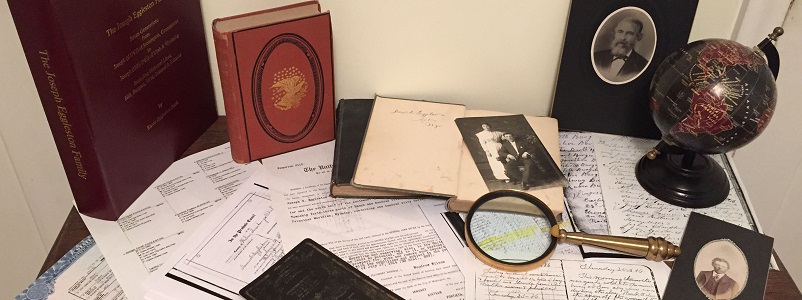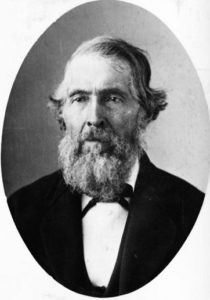
Samuel Eggleston
Early Life of Samuel Eggleston in New York
Samuel Eggleston, son of Samuel & Elizabeth Hill Eggleston was born March 30, 1804 in Marcellus, Onondaga County, New York. He wrote a brief autobiography which states:
“I lived in the town of Marcellus until I was 13 years old, then my father, with his family, then moved into the town of Springwater, Livingston County, state of New York. My brothers and sisters numbered ten in family. I lived with my father until I was 19 years old, then I went to live with my brother-in-law to learn the tanner’s trade. I lived with them until I was 23 years old . . .”
Samuel’s father came to Marcellus in the early 1800’s with his parents and other family members. He bought a piece of land bordering Skaneateles Lake. He sold this land in 1817 which was the time that the family moved to Springwater.
Samuel’s mother, Elizabeth Hill Eggleston, also known as Betsy, died in 1823 in Springwater. Some of the children were still quite young at the time of her death. Samuel was about 19 years old. It was around this time that Samuel went back to the area where he had grown up. His older sister Lucy had married Thomas Marsh and they were living in Sempronius, across the lake from Marcellus. Samuel’s obituary indicates that it was Thomas Marsh with whom he lived for 4 years, from age 19 to 23. He learned the tanner’s trade from Thomas Marsh.
Marriage to Lurania Powers Burgess
On August 23, 1827, Samuel married Lurania Powers Burgess. He was 23 and she was 19 years old. They were married by a Baptist preacher by the name of Gordon. After their marriage, Samuel and Lurania made their home in Sempronius.
Their first son Dwight was born August 9, 1828 and died the following year August 2, 1829. The family Bible indicates that he was born in Sempronius and died in Springwater, Livingston County. Samuel as well as his father Samuel Sr. and father-in-law Harvey Burgess are listed on the 1830 Census in Springwater, so they apparently lived there with both families for a short time. Samuel and Lurania’s next child Benjamin was born April 6, 1830, back in Sempronius and lived only a few weeks. He died April 27, 1830.
While living in the Sempronius area Samuel and Lurania had four other sons: Reuben Burgess born July 24, 1831; Edwin, born October 25, 1833; Harvey Burgess born February 8, 1836; and Orson Hyde born October 3, 1841.
Introduction to the Church of Jesus Christ of Latter-day Saints
Both Samuel and Lurania grew up in Baptist families. Samuel in his autobiography wrote:
“We both belonged to the Baptist Church, then we left that Church and joined the Close Communion Baptists. Then we left it and joined the Freewill Baptists of which we liked better, but I lived with them a few years and I got disgusted with their religion.”
His obituary relates that at the time of their marriage:
“He had previously belonged to the Close Communion Baptists. He subsequently joined the Freewill Baptists. He became dissatisfied with them, and held himself aloof from Christian institutions for a long time.”
The Thorn Hill Baptist Church in Marcellus, where Samuel grew up could be considered a “closed communion” church as their Articles of Faith indicate that only baptized members could take communion. Samuel’s father was a member of this church but was disfellowshipped about the time that the family moved to Springwater. There is information in the church records that Samuel Eggleston later joined “another church of our faith and order.” This would have been in Springwater. Samuel and Thomas Marsh were associated with Free Will Baptists in Sempronius.
Cyprian Marsh, son of Thomas and Lucy Marsh kept a journal in which he related events of the time and his conversion to the Church of Jesus Christ of Latter-day Saints. He mentioned hearing about the Book of Mormon and heard early local convert Zera Pulsipher preach.
In 1832 Mormon Elders, Orson Hyde and Samuel H. Smith went on a Mission through New York. They spent about five weeks in the area of Skaneateles Lake. They were well received and had a good deal of success in the area. Both of their journals mentioned staying at the home of Thomas Marsh in the town of Sempronius. May 2 they went to Sempronius and held a meeting in the evening to a large congregation. It is very likely that Samuel and Lurania attended this meeting or another one held the following day.
Conversion to the Church of Jesus Christ of Latter-day Saints
Apparently seeds were sown from hearing these men preach, though it was several years before Samuel and Lurania joined this church. This may be the period referred to in Samuel’s obituary when he “held himself aloof from Christian institutions for a long time.” Having religious backgrounds, both Samuel and Lurania may have spent this time studying and contemplating, before making a commitment to join a new Church.
In 1840, Elder Pelatiah Brown served a mission in Cayuga County. On June 1, 1841 Elder Brown baptized Samuel and Lurania into the Church of Jesus Christ of Latter-day Saints. Shortly after Samuel and Lurania’s baptism a Branch of the Church was organized in West Niles, Cayauga County. Samuel indicated that Thomas Marsh was made Branch President. He had apparently been baptized sometime before this as well. Lucy Eggleston Marsh had died in 1832.
Apostle Willard Richards was returning from a mission in England in July 1841, and passed through the area, meeting with Saints along the way. Samuel indicated that he was ordained a teacher by Apostle Willard Richards at the time the Branch was organized. Willard Richards’s journal mentions him being in “New Hope in Niles” on July 17-19, 1841. “Elder Thomas Marsh” is mentioned and on the date of July 19 it says: “Teacher Samuel Eggleston”. Samuel’s obituary gives the date of his ordination the 18th of July.
A few months after their baptism, October 3, 1841, another son was born to Lurania and Samuel. They named him Orson Hyde Eggleston. They must have been very impressed with Orson Hyde to name their son after him.
We can only imagine how Samuel and Lurania’s families and friends reacted to their joining this new Church. Accounts of other converts would suggest that there was at least conflict, and at worst outright persecution. Isaac Haight mentioned in his journal that he and his wife were baptized 3 March 1839 “much to the mortification of our friends.” The reaction was probably similar with Samuel and Lurania’s Baptist relatives and friends. Their decision to join with the Saints in Nauvoo may have been in part because things became uncomfortable for them there, but most likely it was in keeping with the Church’s counsel at that time to “gather to Zion” which was then Nauvoo.
Migration to Nauvoo, Illinois
In 1842 Samuel and Lurania, with their four young sons, moved to Nauvoo, Illinois. Isaac Haight, who had been called to preside over the Moravia Branch, led a group of Saints to Nauvoo that summer. Samuel and Lurania, along with Cyprian Marsh, were part of this group. Isaac Haight’s journal states that on June 7, 1842 he “started for Zion in company 9 wagons, traveled 18 miles and encamped, waited all day for S. Eggleston.” Apparently Samuel and Lurania were delayed for some reason as they arrived at the place of meeting considerably later than the rest of the group expected them. Brother Haight did not mention names of other members of the group, and Cyprian Marsh’s journal mentions only “Brother Haight, Sharp, Eggleston and others.”
Isaac Haight’s Company traveled 13 miles in the rain the first day, then 19 miles and camped in a grove in Wards Inn, then arrived at the Canal the next day. Along the way they apparently had some meetings, which probably included any interested people in the area. Haight’s journal mentions that the evening of the day they waited for S. Eggleston, he preached “in the evening to a numerous congregation.”
Upon reaching the Canal, which he identified as Genese Valley Canal, Haight states that “by the solicitation of the company took charge of the goods of the company.” He then “left the company and my wife and little daughter and took passage on board the boat Congress.” Probably with limited funds as well as the number of wagons and animals, it was not practical for the whole group to travel by boat, but may have been advantageous to ship some of their “goods”, probably large furniture, tools, etc. Isaac Haight continued his journey by Canal boats and steamers on the lake and rivers. The rest of the company continued overland with their wagons. Cyprian Marsh indicates they traveled through the states of Pennsylvania, Ohio, Indiana, and Illinois. Isaac Haight arrived in Nauvoo on July 5th and stayed with Bro. C. Barrus until the wagons arrived. His journal states that July 24th “The wagons arrived the company being all in good health.”
Life in Nauvoo, Illinois
By the time Samuel and Lurania arrived, Nauvoo was a growing and thriving city. The Eggleston home in Nauvoo was located on Lot 1 of Block 62 on the corner of Hibbard and Woodruff Streets, only a few blocks north of the Temple site. Their lot would have been large enough for a garden, but Samuel did not have sufficient land to farm in or outside of the city.
Samuel probably made a living as a tanner and shoemaker in Nauvoo. He is listed on the Seventies record as shoemaker. He, like many Nauvoo residents, may have supplemented this with odd jobs at times. In the spring of 1845 Samuel was hired by Brigham Young to build a rail fence around his home. (Nauvoo: A Place of Peace, A People of Promise by Glen M. Leonard Deseret Book 2002 p.140, source given Temple committee Ledger C. April 12, 21, May 15, 1845, in “Fences” Lyon Collection.)
Samuel and Lurania were involved in the activities and witnessed all the events of that time in Nauvoo. Samuel worked on the Temple, then under construction. It was a common practice for men to work one day out of ten on the Temple as their “tithing.” Also like most men in Nauvoo, Samuel was a member of the Nauvoo Legion. He was elected first sergeant of a company in the Nauvoo Legion and later Captain of the same company.
Having been ordained a Teacher in Niles, Samuel continued as a member of that Quorum in Nauvoo. Joseph Smith’s journal records:
“Oct. 7, 1842—This day the teachers met in Nauvoo and organized into a Quorum by appointing Elisha Averett Pres., James Huntsman and Elijah Averett, Counselors, Samuel Eggleston, scribe and 11 members” (vol 5:161-History of the Church-Joseph Smith).
This would have been only a short time after Samuel arrived in Nauvoo. Samuel was later ordained an Elder and a Seventy in October 1844. He was a member of the Ninth Quorum of Seventy. Meeting notes mention in most meetings the members “speaking their feelings”, so Samuel was probably an active participant in the Quorum. The 9th Quorum of Seventy kept track of its members after they left Nauvoo, with Samuel being listed as being in Iowa May 29 1852, and in Kanesville, Iowa March 10, 1953 and 23 April 1856.
Samuel and Lurania received their endowments in the Nauvoo Temple January 9, 1846, and were sealed January 28, 1846 in the Nauvoo Temple. At this time there was much urgency to endow as many Saints as possible before leaving Nauvoo, and Samuel and Lurania would have joined the crowds waiting for this privilege.
From Nauvoo to Nebraska
The Latter-day Saints were driven from Nauvoo in early 1846. The first group began the exodus February 4th. Samuel and Lurania did not leave immediately. They were still in Nauvoo on March 8. That day, being Sunday, a meeting was held in which Orson Hyde, who was the only member of the Twelve Apostles remaining in Nauvoo, addressed the congregation. That evening a Prayer meeting was held in the Temple with eighteen Elders present. Franklin D. Richards and Samuel Eggleston gave the prayers. (Journal History 8 Mar 1846 p. 2)
Samuel’s account says they left Nauvoo “in the spring of 1846”. They may have stayed because of lack of funds or supplies, attempting to sell land, or to assist with completing the Temple. The largest numbers of Saints left Nauvoo between March and May. The Temple was finally completed and dedicated May 1, 1846.
Joseph Hovey, in his autobiography, told of his departure from Nauvoo about June 28. He described an ordeal getting their wagon and animals across the Mississippi River. He arrived on the other side about 4 o’clock. He stated: “I hitched my cattle on the wagon and we started for the Jack Oak Grove, along with Brother Eggleston and a number of others.” So it appears that Samuel and his family left Nauvoo at the end of June. Mob violence had already begun in Nauvoo, though the worst came after they left. This account of Joseph Hovey describes a difficult journey across Iowa with them reaching the Missouri River about the first of September. (Joseph Hovey Autobiography, BYU-S, p. 37-40)
The Egglestons went to Winter Quarters in Nebraska, where the Saints gathered to prepare to go further west. There small cabins were built where they spent a miserable winter. Many of the Saints were ill prepared for such a trip. There was inadequate food for the many refugees camped there and diseases spread easily.
Another son, Samuel, was born to Lurania and Samuel in Winter Quarters, January 16, 1847. Patty Sessions was Lurania’s midwife and recorded the birth in her diary. Her account book shows that Samuel Eggleston paid $2.00 for her services Jan 16. This child lived only until August 2, 1847. He was buried in the Mormon Pioneer Cemetery in Winter Quarters.
Life in Council Bluffs, Iowa
In 1848 the Egglestons moved back across the Missouri River to Council Bluffs after the first of the Saints had left for the Salt Lake Valley. They stayed in the Council Bluffs area for 13 years, long past the time most of the Saints had gone to Utah. In a brief autobiography, Samuel’s son Orson said:
“My father not having means to come west with the pioneers moved back across the Missouri River into Iowa. Lived for a time at Trader’s Point, then went to Council Bluffs and lived for a time, then went 7 miles north to Crescent City.”
The Eggleston family first lived at Trader’s Point. It was here that Samuel and Lurania’s last child and only daughter was born September 22, 1849. They named her Mary Elizabeth after her grandmothers Mary Titus Burgess and Elizabeth Hill Eggleston. The Egglestons moved to Council Bluffs, or Kanesville as it was renamed, around 1850 or 1851. (His obituary says they moved the spring of 1851)
Family tradition says that Samuel was asked by Brigham Young to remain to make shoes for the Saints who would be traveling west. This may have been a reason initially, however other factors may have influenced them to stay so long. Samuel did have a Boot and Shoe shop in town and advertised in The Frontier Guardian.
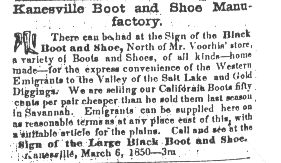
This Ad ran from March 6 to June 12, 1850. Samuel’s name is not given, but the location would indicate it was his shop.

Advertisement in the Frontier Guardian and Iowa Sentinel December 23, 1852-May 12, 1853
A Guardian and Sentinel Directory published in the Frontier Guardian and Iowa Sentinel from March 24 to May 12, 1853 lists: Shoemaker Shop, Samuel Eggleston-Next to the Bridge, Madison.
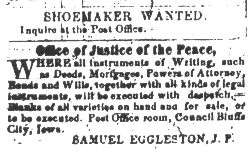
Ad in the Western Bugle from October 27, 1852 to September 7, 1853 and from September 21 to December 21, 1853
Samuel also worked as a Justice of the Peace at this time and performed marriages.
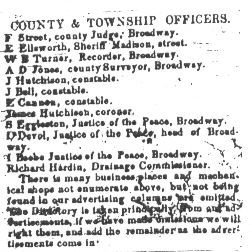
City Director printed in the Western Bugle from September 14 to December 21, 1853
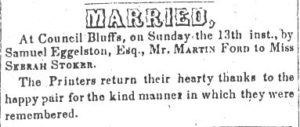
Samuel and Lurania eventually owned a great deal of land in Pottawatamie County. Samuel was a Notary Public for nine years. Pottawatamie County Deed books show deeds written and recorded by Samuel Eggleston, Notary Public. Samuel also served as Postmaster for five years.
Before the Saints came to Council Bluffs, it was only a trading post and Indian agency. Through the next few years, settlements were made, with all the elements of civilization that the Saints had brought to Nauvoo. It appears that Samuel and Lurania were part of this civilizing influence and took an active part in the established community of these growing frontier towns. The first schools in the area were established by Mormon settlers, which schools their children would have attended. Council Bluffs also became a major outfitting point similar to Independence and St. Joseph, for those migrating westward. Samuel’s shoemaking business would have been a valuable asset to the community.
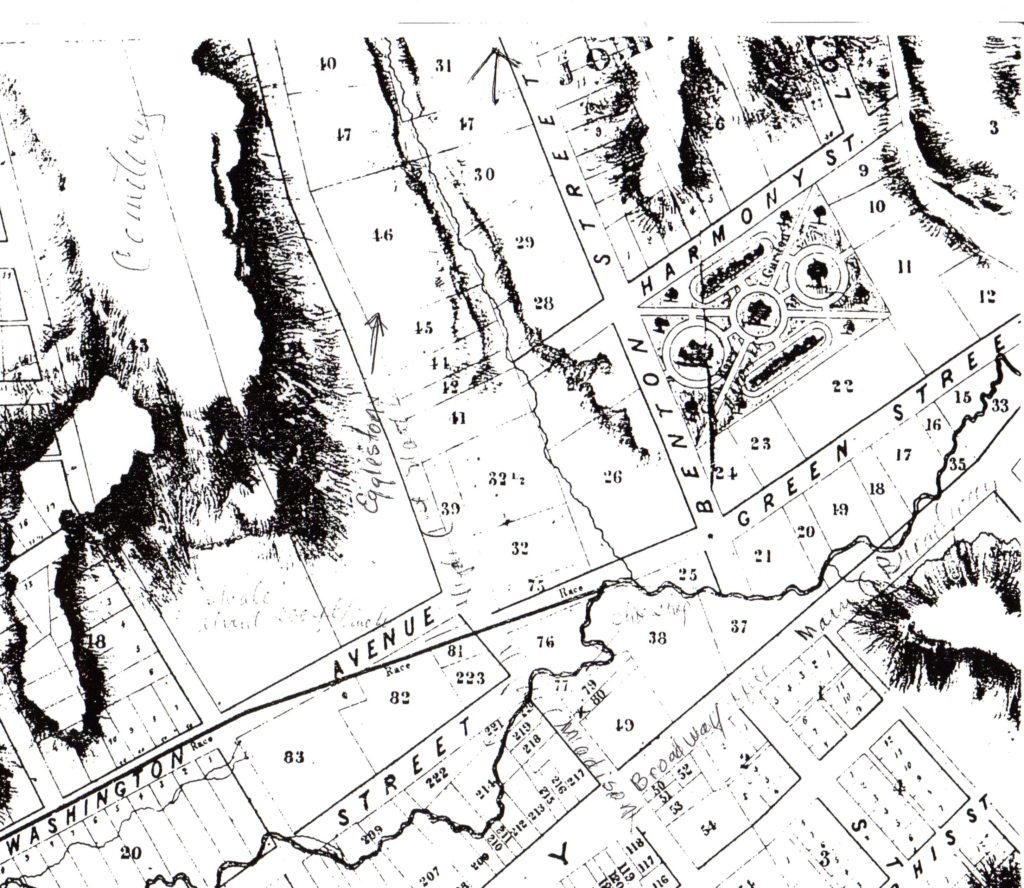
Map of Kanesville. X on Lot 80 shows where Samuel’s Shoe Shop was located. The arrow points to Lot 46 which Samuel owned and where they likely lived.
Kanesville in 1850 had a population of about 400, all Mormons. The buildings were all made of logs, and mostly one story. The main streets in Council Bluffs or Kanesville were Hyde Street, later named Madison and Main Street which was later named Broadway. The early business district was in the area where these two streets intersect and extending down further both ways on Broadway or Main. Samuel’s Shoe Shop was on Madison Street, by the bridge, which was near where Broadway intersected Madison. Most of the early residences extended up the glen on First Street. Samuel owned land in Council Bluffs on Lot No. 46 which was on First Street, also described as the road to the Cemetery.
Disaster and Heartbreak in Council Bluffs
In November 1853 fire broke out and destroyed much of the business district in Council Bluffs. Samuel’s Shoe Shop was across the street from most of these businesses. This account was published in the Deseret News in Salt Lake City:
Destructive Fire at council Bluffs City
Editor of the Deseret News:——
Sir: The last mail brought me news that a large portion of the business part of Council Bluff City has been destroyed by fire. The amount of property was very large; but the amount of loss to the owners is uncertain, not knowing what amount of insurance there was; but it is presumed that but a small portion was insured, as the rates were very high, owing to the combustible materials of which the buildings were made.
I make an abstract from a letter from my wife on the subject:
“On the night of the 11th of November, between 10 and 11 o’clock, a fire broke out in the store of Tootle & Jackson, and spread both ways, east and west, consuming every building until it reached Murphy’s store.
“Such a sight my eyes never before beheld. In the space of about 30 minutes, the whole block was in flames. You cannot conceive, neither can I describe the scene that took place. It seemed for a time, that the whole city was to be consumed. For miles, it was as light as noon-day. We could see men, women, and children, running in every direction, throwing water, tearing down houses and other buildings, in order to stop the progress of the flames.
“The Emporium Buildings, including the two printing offices, (the Guardian and Bugle) together with the Post Office, were consumed with their contents. The stores of Stutsman and Donnell; Martin & Mason; Tootle & Jackson; Pegram & Bartlett; the saloon of Mitchell; the whole Emporium Building; the store of Barrow & McLaughlin; Hawk & Co.; the Bluff House; with many other buildings, including the new dwelling of Mr. Stutsman, the bakery of Mitchell; the wagon shop and blacksmith shop of J. E. Johnson; the stables and carriage houses connected with most of the buildings, were included. Very few of the contents were saved. It truly throws a gloom over our young city.”
From other letters from Messrs. Voorhis and McMahon, this letter is fully corroborated; but yet, it seems that there is a determination on the part of the sufferers to re-build with more substantial materials.
The rail-road excitement is on the increase, and from all appearance, Council Bluff City is destined to become a point of considerable interest.
I am with high respect and consideration,
Your ob’t serv’t, A. W. Babbitt
(The Deseret News [Salt Lake City, Utah], January 19, 1854)
Samuel and Lurania’s son Harvey died February 12, 1854, in Council Bluffs. The circumstances of his death are unknown, though it is interesting that his death was just a few months after this devastating fire.
Crescent City, Iowa
Around 1856-1857, Samuel moved to Crescent City, a few miles north of Council Bluffs. A History of Pottawattamie County lists among early settlers of 1857, S. Eggleston.
Samuel’s autobiography states that he “was elected Justice of the Peace in the first election held in Pottawattamie County, which office I held for 10 years.” This would have included service in Council Bluffs and later in Crescent City. A History of Pottawattamie County indicates that at the first election in Crescent City, A. J. Williams and Samuel Eggleston were Elected Justices of the Peace. There is no date given for this “first election”, though it likely was in 1857. The Crescent City Newspaper, The Oracle, dated Oct. 22, 1858, printed Election Returns for Pottawattamie County Elections. Among those listed is Justice of the Peace, Samuel Eggleston, Wm D. Frazier.
A History of Pottawattamie County mentions Samuel Eggleston as having one of the first businesses in Crescent City. Joseph E. Johnson, who had owned several businesses in Council Bluffs, erected the first business house in Crescent City in the spring of 1856. This was located on the north side of Florence Street, west of Johnson Avenue, obviously named for him. Samuel Eggleston built another building shortly after that on the southwest corner of Florence Street and Johnson Avenue. The Eggleston family owned considerable amounts of land in Pottawattamie County, some in Council Bluffs and more in Crescent City.
Migration to Utah
In 1852, L. D. S. Church President Brigham Young called for all the Saints in Iowa to come to Utah. There was a great migration that year and many accounts indicate that “all of the Saints left Iowa and went to the Salt Lake Valley.” Many did go on to the Salt Lake Valley then, though some remained. For some reason the Egglestons did not go in 1852 with this large migration. Pottawattamie County newspapers printed news from Salt Lake City and about the Pioneer Companies heading to Zion, so they apparently maintained close contact with the Saints in Utah.
After the migration of 1852, the town was described by some as “deserted” and the departure of Orson Hyde left them without a church authority presiding. Changes in the Mormon immigration route from Europe shifted in 1854, with ships sailing into Boston, New York or Philadelphia, rather than traveling up the Mississippi River from New Orleans. With these changes and the railroad going further west, Council Bluffs was no longer the starting point of the trail west for the Saints.
The Egglestons remained as part of the established community, though the atmosphere in Council Bluffs was probably very different. Perhaps this was because of their business, public service and land holdings. The move later to Crescent City may have been because of undesirable influences in Council Bluffs, or because of the availability of new land and opportunities in a newer community.
After the Civil War started, there was another, probably more urgent call for all Saints to leave the eastern United States. The migration of Samuel and Lurania’s family to Utah in 1861 and 1862 was likely in response to this call.
William Ellis Jones relates in his diary that in November (probably 1860) several Elders from the Salt Lake Valley came to Council Bluffs. Among them were William Martindale and James Wareham. James Wareham would later lead the company in which Samuel and Lurania came to the Valley in 1862. These Elders stayed in the neighborhood all winter. During that time they organized a Branch of the Church in Crescent City. William Ellis Jones was made Branch President with Br. Eggleston 1st counselor and Br. Henry Brooks, 2nd counselor.
Orson’s autobiography mentions that in the winter of 1860-61 his “father and mother renewed their covenants by baptism and I was baptized into the Church, was ordained an Elder that winter, also my brother Reuben.” It was a common practice for members to be re-baptized as a sign of re-commitment. Since the Church members had been without strong Priesthood leadership since Orson Hyde left in 1852, there may have been some apostasy or straying. The efforts of these visiting Elders was probably directed toward setting the affairs of the church in order. This would involve organizing Branches as well as dealing with individual members.
Samuel and Lurania’s oldest living son, Rueben was married July 15, 1856 to Emeline Allen. Orson indicates that “In the summer of 1861 my Brother Reuben and family and myself came to Utah and settled in Ogden.” They traveled together with the David H. Cannon Company. Bartlett Tripp, clerk of this company, recorded a list of company members in his camp journal. Listed is Reub. B. Eggleston, wife and 1 child, Orson Eggleston, 4 oxen, 1 cow, 1 wagon.
Orson was called to be a teamster the following year and returned to bring others to Utah, including his family. They traveled with the James Wareham Company, which left Iowa in July 1862. Samuel and Lurania sold much of their land in Pottawattamie County just prior to that.
The Deseret News reported, 16 September 1862 –The day was warm in G. S. L. City. Elder Amasa M. Lyman & Charles C. Rich & Co arrived in Salt Lake. Capt James Wareham’s Independent Co. members—Samuel, Lurania, Orson H. & Mary E. Edwin, Eliza R. Charlotte & John H. (Journal History 16 Sep 1862) Edwin came to Utah then with his wife and two children, but later returned to Council Bluffs.
Life in Ogden, Utah
Samuel and Lurania settled in Ogden, Utah. They were members of the Second Ward where Samuel was ordained a High Priest in 1863 (Church Hist dept notes says 1864) by F. A. Hammond and others. May 30, 1877 he was set apart as First Counselor to Bishop Robert McQuarrie of the Second Ward. His obituary indicates he held that position until his death. He was ordained a Patriarch by George Q. Cannon, Joseph F. Smith, F. D. Richards and D. H. Perry on October 24, 1882.
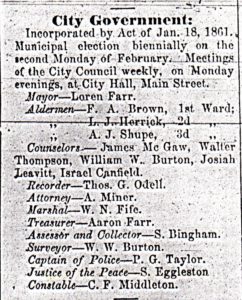
Officers of Ogden City – S. Eggleston Justice of the Peace (Probably 1869-1870)
Samuel continued to work as a shoemaker in Ogden. In 1877, the “Ogden Junction” published a list of shoemakers which included Samuel Eggleston.Samuel also served as Justice of the Peace in Ogden.
Samuel appears to have been a well respected member of the community in Ogden. He served faithfully in leadership positions in the church as well as public service. He apparently was a close friend of prominent leaders in the area. The first Mayor of Ogden, Lorin Farr, who was also his daughter’s father-in-law, and Apostle Franklin. D. Richards, who was the presiding L.D.S. authority in the area, spoke at his funeral.
Samuel was involved in community events and decisions. Heart Throbs of the West Vol. 3 tells about the building of the Ogden Tabernacle. This would have been one of the most significant buildings in the city. This building had been dedicated around 1859-1860, prior to Samuel’s coming to Ogden. December 24, 1880 a petition was presented to the city council requesting that the land known as Tabernacle Square to be conveyed to David H. Peery, Lester Herrick and Charles F. Middleton in trust for use of members of the L.D.S. Church. Among signers of this petition were Franklin D. Richards, Chris Flygare, Winslow Farr, John Hastings, Winthrop Farley, F. A. Hammond, Samuel Eggleston, B.C. Critchlow, James Burch and Joseph Taylor.
Other Marriages
Lurania died July 6, 1870 of smallpox at the age of 61 years and 11 months. She was buried in the Ogden City Cemetery. After Lurania’s death Samuel married Elizabeth Mumford and Catherine Kat. The family Bible records:
“Mary E. Mumford was born May 14th 1854 in Burnstown, Staffordshire, England. Samuel and Elizabeth was married Oct 24th 1870 at Salt Lake City Utah. Catherine Kat was born April 5th 1836. Samuel and Catharine was married the 6th day of March 1871 in Salt Lake City Utah by Daniel H. Wells.”
Mary Elizabeth Mumford would have only been 16 years old in 1870 and the marriage date is only a few months after Lurania’s death. It is possible that she was a recent immigrant from England, who had no family here and he was encouraged to marry her to provide her with a home. I have found no other mentions of her and wonder if this marriage lasted any length of time.
The marriage to Catherine Kat was only a few months after this marriage, but there is no indication in any family records, letters, etc., that Samuel was a polygamist and was married to both at the same time. Catherine would have been considerably younger than Samuel, but about 35 years old at the time of the marriage. In letters Orson wrote to his father from his mission to Michigan in 1876 he says “My respects to Catherine and all the rest”. Samuel’s journal entries in his copy of “The Times and Seasons” mentions only a wife in 1779 and 1883. Samuel’s obituary mentions only his “widow”. No names are given in either of these.
Samuel’s Last Days
Samuel owned a bound volume of “The Times and Seasons”. This was a newspaper which had been printed in Nauvoo, Illinois. Papers from 1842 and 1843 were bound in this Volume IV, which he owned. On the front blank pages in the book, Samuel made some journal entries.
An article in the Ogden Daily Herald Thursday March 30, 1882 states:
“We congratulate him. Mr. Samuel Eggleston has attained the 78th year of his age. He has been identified with the Mormon people over forty years and has followed the Church in all its meanderings and trials from her first connection with it to present times. Bro. Eggleston, today, is hale and hearty and looks as though he might live for many years to come. We congratulate him and wish him many happy returns of the day.” (Journal History 30 March 1882)
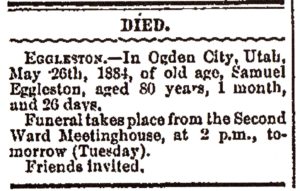
Samuel died May 24, 1884. He was buried in the Ogden City Cemetery next to Lurania. His funeral was well attended and he was eulogized by prominent members of the community. He did leave a will.
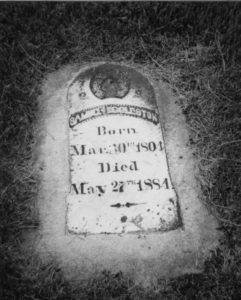
Notes & Sources:
Because of the length of this post, Samuel’s Obituary and funeral program as well as his Probate Record are in a separate post.
Chapter 8 of my book, The Joseph Eggleston Family covers the family of Samuel Eggleston and Lurania Powers Burgess, p. 375. This account was adapted from that and a history written by myself and submitted to the Daughters of Utah Pioneers. Sources cited there include:
Family Bible, photocopied from the personal Bible of Orson Hyde Eggleston
Brief Autobiography of Samuel Eggleston from records of Laura Eggleston Cutler (DUP)
Pioneers and Prominent Men of Utah
Histories of Orson Hyde Eggleston by Virgie Eggleston Stoffers (DUP) and Karen Eggleston Stark (DUP) and Pioneers and Prominent Men of Utah
Autobiography of Orson Hyde Eggleston written for Utah Genealogical Society
History of Lurania Powers Burgess Eggleston by Karen Eggleston Stark (DUP)
“History of Pottawattamie County, Iowa” by Homer H. Field and Hon. Joseph R. Reed Vol. 1 (1907)
“History of Pottawattamie County Iowa” (Chicago: O.L. Baskin & Co., Historical Pub. 1883) p. 285-292.
Pottawattamie County Newspaper Articles and Advertisements: “The Oracle” Oct 22, 1858; “The Frontier Guardian and Iowa Sentinel” 1852, Dec 23 or 30—1853, May 12; 1853, Mar 24-May 12; “The Western Bugle” 1852, Oct 27-1853, Dec 21.
“Mormon Midwife, 1846-1888 Diaries of Patty Bartlett Sessions” Edited by Donna Toland Smith (1997 University of Utah Press) p. 70.
Journals of Orson Hyde, Samuel H. Smith, Willard Richards, Isaac Haight (L.D.S. Church Hist. Dept. Archives)
Journal of Joseph Hovey, BYS-S p. 37-40)
Journal of William Ellis Jones, Utah Historical Society
Biography of William Nicol Fife, Pioneer Heritage Library CD ROM
Journal History of the Church, including Deseret News Articles
Ogden City Cemetery Records
Winter Quarters Cemetery Records
Seventies Record 9th Quorum (L.D.S. Church Hist. Dept. Archives)
Newspaper Articles The Ogden Junction and Ogden Daily Herald
Nauvoo Land Records
Pottawattamie County Land Records
U.S. Census Records
1856 Iowa State Census
Nauvoo: A Place of Peace, A People of Promise by Glen M. Leonard Deseret Book 2002
Journal entries in Samuel Eggleston’s copy of “The Times and Seasons”
Missionary Experiences of Cyprian Marsh, copied by his Grandson Aurthur Marsh Taylor (DUP) from Cyprian Marsh Collection, J. Willard Marriott Library, University of Utah
Beneath Ben Lomond’s Peak by Milton R. Hunter, p.321 quote from “Ogden Junction”, p. 151, and p. 511.
Records of Marcellus Baptist Church
